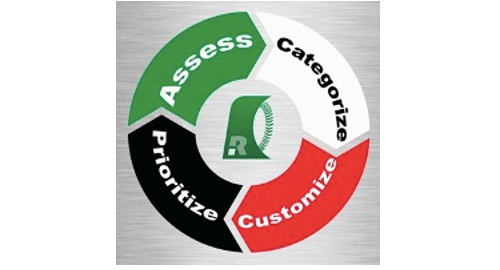Ron Wolforth probably knows more about the throwing arm and arm care than anyone we know. Many of you may have heard about the famous Texas Baseball Ranch that Ron has been running for many years. We have built a great relationship with Ron and his wife Jill over the years.
It all started a few years back when Ron sent his son Garrett to a Perfect Game event. His son was a catcher/infielder and set some all-time PG records for pop times (1.75) and velocity (89 mph) at the time. He also threw mid-90s across the infield. He is now playing professionally. Being an average-sized kid, this really drew our interest. Once we realized who his father was, it became clear.
Since then we have followed the Texas Baseball Ranch closely. Ron is a very humble man, which is a reason so many speak highly of him. We have never run across a single person that shows any disrespect for him or the Ranch. So we decided to ask him to help our millions of followers.
Over the years he has helped thousands of pitchers, including many that became Major League All-Stars. Yes, he teaches velocity gains, better control and command, and everything a pitchers needs to be successful. However, unlike many others, he is an absolute stickler when it comes to doing it safely. His interest doesn't just involve velocity gains and other improvements, all of which are very important. He wants his students to understand arm care and how to throw and stay healthy. He does this without a cookie cutter program. He understands that all players are different individuals.
Perfect Game's interest in prospects, arm care and keeping young kids healthy is the major reason we have decided to work with Ron Wolforth.
Below is the fourth of an ongoing column he will be doing on our Perfect Game website. This information will be gold for any player interested in improving their throwing ability and staying healthy. Make sure you read every column he contributes and feel free to comment on them.
If you want to attend one of his camps and improve your throwing ability, here is the link to the website:
https://www.texasbaseballranch.com/
Jerry Ford
President
Perfect Game
. . .
Article 1: Where the Sidewalk Terminates
Article 2: The Exact Location of Your Arm Pain is Incredibly Valuable Information
Article 3: No Pain, No Problem...Right? Not Quite So Fast.

In my opinion, one reason many of us dislike being treated like a number is that we intuitively understand that we cannot ever separate ourselves from the herd by behaving in lockstep with the herd.
Achievement, by definition, is, "the process of separating ourselves from the mass collection of the average and the mediocre.” That is very difficult to do when doing exactly what every one of our peers is doing.
We all know instinctively that one size will not only not fit everyone, it will not fit even one forever.
We are often drawn to “the recipe” as if our career was the equivalent of making a great Caesar salad. Yet, we innately understand that our career is decidedly much more complex than a Caesar salad.
We occasionally seek “the magic bullet” as if our training success or failure is some sort of magic trick. Yet deep down inside, we realize that long-term success is not about finding a “trick” or a “hack”, but instead, it is attained only by following a specific process. That sustained success requires work ethic, commitment, and dedication.
We are too frequently lured to “choreography” and “cookie cutting” as if our lives can be explained by a mathematical equation. Yet, we hate when we are viewed or treated like “a number” or a “replaceable cog” in a machine. Each and every one of us are unique to the universe, with our own special gifts and shortcomings. We desperately want to be treated as such.
However, these One-Size-Fits-All programs are seemingly everywhere, aren’t they? And in almost every facet of our lives! They are like stars in the sky.
- Diets to amazing weight loss in 14 days!
- Financial tips to unimaginable wealth!
- Relationship maxims which will make your marriage the envy of the neighborhood!
- The latest putter that is guaranteed to shave three stokes off your round!
- Etc...Etc.
Simply find a niche and you will find a mystical methodology or tool which will magically solve your problems in that area.
In the quiet of our own hearts and minds, we all know that these efforts at “oversimplification”, “cloning”, or “cookie cutting” run the gamut from woefully insufficient and a waste of time, money, and effort, to patently false and fraudulent.
I have found the following analogy to really resonate with young parents and their athletes when it comes to the danger of One-Size-Fits-All programing.
What Sir Alexander Fleming's Discovery Can Teach Us About Hyper-Personalization...

One of the most common questions I have been asked by medical professionals over the last 50 years of my life is:
“Mr. Wolforth, are you allergic to any medicines? Are you allergic to penicillin?”
I’m confident that all of you reading this have been asked this question multiple times yourself, or at the very least, had a parent or a guardian answer it for you.
So why the question?
Approximately 10% of all U.S. patients report having an allergic reaction to a penicillin class antibiotic in their past. Furthermore, about .8% (slightly less than 1%) report having a serious hypersensitivity, sometimes resulting in nausea, vomiting, pruritus, urticaria, wheezing, laryngeal oedema, and ultimately, possible cardiovascular collapse.
- So for 90% of people, penicillin class antibiotics are a perfectly appropriate tool for physicians and health professionals to use on their patients should they have an infection
- For 9% of people, it is probable that another class of antibiotic would be a more appropriate choice
- For <1% of the population, getting this choice wrong could be deadly
Thus, the frequent question.
As with many things in life, often we need to ask a better/deeper question.
What if we stop our investigation at, "Is penicillin a good thing, yes or no?"
The obvious answer is...Yes! Penicillin has saved millions of people's lives and saved multiple millions from further pain and discomfort.
But even with something as amazingly effective as penicillin, not everyone will benefit from it. For a small percentage of people, penicillin could prove fatal.
One size does not fit all...One size will NEVER fit all!
So, What is the Alternative?
In my 25+ years of experience in developing pitchers and elite throwing athletes, the answer to that question has become abundantly clear to me. The best, most effective, and most accelerated training process is, and always will be, Hyper-Personalization.

What exactly is Hyper-Personalization?
I first heard the term used by Dr. Marcus Elliot, Founder of P3 Applied Sports Science, during a private conversation he and I had about skill development around 2014.
I thought it was brilliant and described our assessment goals exceptionally well, and we've been using the term ever since.
‘Hyper-Personalization’ is the process of utilizing very specific assessment modalities to generate a more precise and current understanding of the skills, abilities, constraints, and limitations of the individual athlete.
By viewing the athlete through a multiple set of prisms, an intentionally wide and far more thorough understanding of the athlete’s current status can be created from that information.
This process allows the athlete's trainer to customize the training of the athlete based upon that current status, and thereby maximize the effectiveness and efficiency of his training.
Next, let me attempt a bit of humor and a subsequent analogy to demonstrate the efficacy and common sense of the process of Hyper-Personalization.
The story goes that when a player brought in a mid-season academic progress report to Coach Shelby Metcalf, the basketball coach at Texas A&M University, that had four F's and one D on it, Coach Metcalf looked it over for the longest time, took a deep breath, and replied:
"Son, looks to me like you're spending too much time on one subject."
I vividly remember reading that quote from a newspaper article while I was traveling on a plane when I was coaching at the University of Nebraska in 1987. I remember that I laughed so hard that my stomach ached for days afterward.
That humorous story (at least it is in my estimation) brings me to the analogy of why hyper-personalization is so effective.
Imagine if your 17-year-old son had the following grades on a mid-semester academic progress report:
Math: 94
Chemistry: 97
English: 79
History: 95
Biology: 91
Would you:
A. Get tutors in every subject, just to make sure.
B. Get a tutor in chemistry because you heard that this tutor is amazing.
C. Get a tutor in math because everyone who got accepted into Rice University from your school had this tutor.
D. Get a tutor in English because this subject currently is his greatest need and with specific help, he may be able to bring his English grade up to be on par with the rest of his grades.
Most people, I believe, would choose D.
We only have so much time available to us in a 24-hour period.
In our opinion, to maximize our return on training time (ROTT), we must focus on the elements that we believe have the greatest impact upon our overall performance.
Going from a 97 to a 99 in chemistry will almost certainly not be nearly as impactful as would significantly improving our English grade.
This is what the Hyper-Personalization process looks like to us at the Texas Baseball Ranch®:

1. Evaluate the athlete on multiple fronts. (Assess)
2. Determine where the athlete is currently and identify the key constraints and limitations he is currently facing. (Categorize)
3. Individualize their personal plan. (Customize)
4. Determine which elements are the most pressing. (Prioritize)
In our 15 years of training elite throwing athletes, we have found the most common 15 needs/constraints/limitations of throwing athletes ages 14-22 are these:
- Arm Health and Durability
- Consistency and ability to recover/bounce back
- Velocity
- Command
- Inability to create swing-and-miss stuff
- Mindset/Confidence/Mental-Emotional
- Sleep/Nutrition/Hydration
- Strength/Stability
- Mobility/Flexibility
- Physical Structure and Alignment
- Mechanical Efficiency
- Poor/Inefficient Ramp Up
- Workload/Volume
- Strategy/Pitch Design
- Skill Specific Conditioning/Stamina
In my opinion, there couldn't possibly be a One-Size-Fits-All plan that will adequately address these 15 common constraints.
This is exactly why Hyper-Personalization is, and will ALWAYS remain, in my opinion, the best process in creating and nurturing high-level performers.
I look forward to continuing our discussion.
Ron Wolforth
CEO - The Texas Baseball Ranch®
P.S. My next topic will be "The Case Against Weighted Balls?"
Coach Wolforth has written six books on pitching including the Amazon Best Seller, Pitching with Confidence. Since 2003, 122 of the players Wolforth has trained have been drafted and 458 have broken the 90mph barrier. He has consulted with 13 MLB teams, dozens of NCAA programs and has been referred to as “America’s Go-to-Guy on Pitching” and “The Pitching Coaches Pitching Coach”. Coach Wolforth lives in Montgomery, Texas with his wife, Jill. They are intimately familiar with youth select, travel baseball and PG events as their son Garrett (now a catcher in the Cincinnati Reds organization) went through the process. Garrett still holds the PG Underclass All-American Games record for catcher velocity at 89mph which he set in 2014 at the age of 16.
If you would like a free copy of Pitching with Confidence, go to freepitchingbook.com.